2010 FORD F150 battery
[x] Cancel search: batteryPage 265 of 419
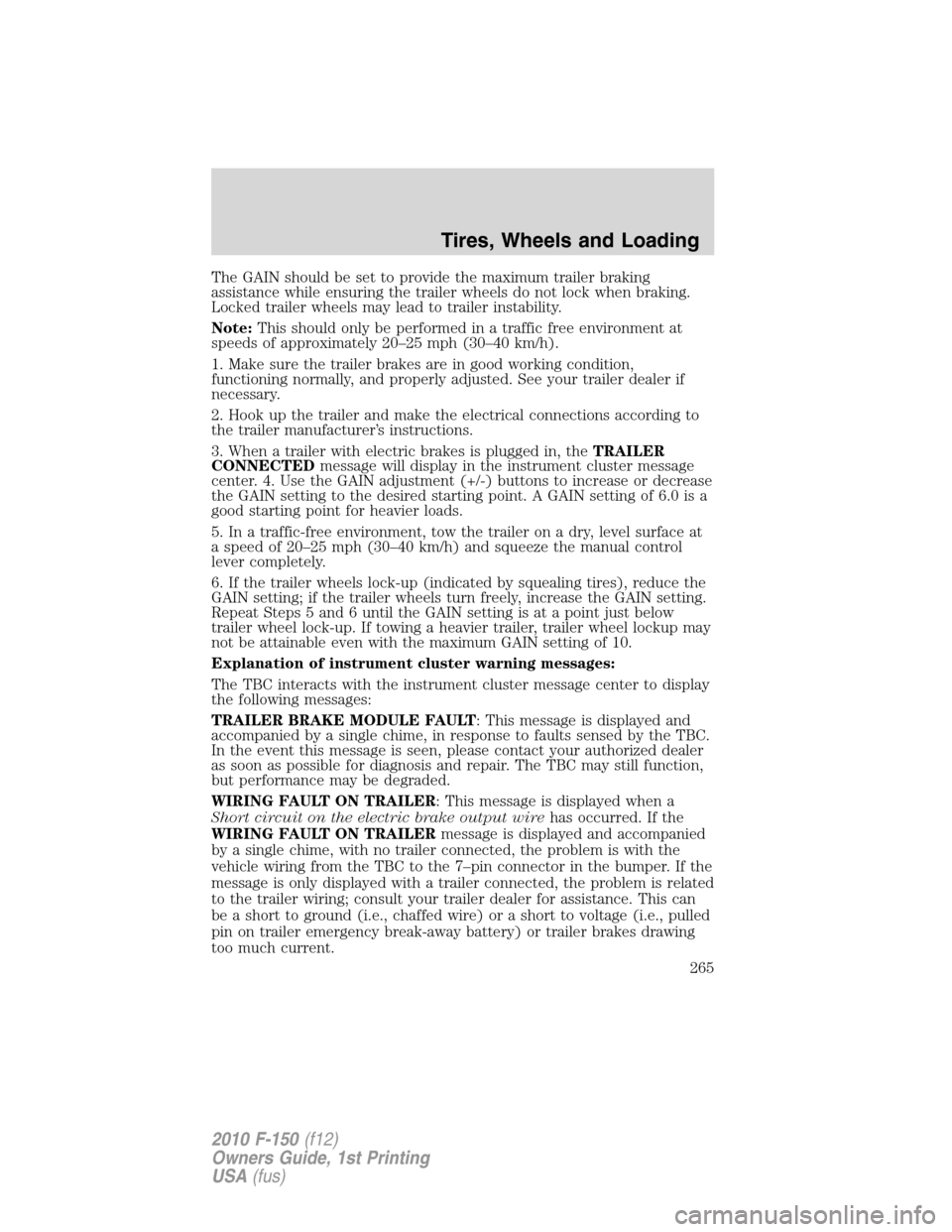
The GAIN should be set to provide the maximum trailer braking
assistance while ensuring the trailer wheels do not lock when braking.
Locked trailer wheels may lead to trailer instability.
Note:This should only be performed in a traffic free environment at
speeds of approximately 20–25 mph (30–40 km/h).
1. Make sure the trailer brakes are in good working condition,
functioning normally, and properly adjusted. See your trailer dealer if
necessary.
2. Hook up the trailer and make the electrical connections according to
the trailer manufacturer’s instructions.
3. When a trailer with electric brakes is plugged in, theTRAILER
CONNECTEDmessage will display in the instrument cluster message
center. 4. Use the GAIN adjustment (+/-) buttons to increase or decrease
the GAIN setting to the desired starting point. A GAIN setting of 6.0 is a
good starting point for heavier loads.
5. In a traffic-free environment, tow the trailer on a dry, level surface at
a speed of 20–25 mph (30–40 km/h) and squeeze the manual control
lever completely.
6. If the trailer wheels lock-up (indicated by squealing tires), reduce the
GAIN setting; if the trailer wheels turn freely, increase the GAIN setting.
Repeat Steps 5 and 6 until the GAIN setting is at a point just below
trailer wheel lock-up. If towing a heavier trailer, trailer wheel lockup may
not be attainable even with the maximum GAIN setting of 10.
Explanation of instrument cluster warning messages:
The TBC interacts with the instrument cluster message center to display
the following messages:
TRAILER BRAKE MODULE FAULT: This message is displayed and
accompanied by a single chime, in response to faults sensed by the TBC.
In the event this message is seen, please contact your authorized dealer
as soon as possible for diagnosis and repair. The TBC may still function,
but performance may be degraded.
WIRING FAULT ON TRAILER: This message is displayed when a
Short circuit on the electric brake output wirehas occurred. If the
WIRING FAULT ON TRAILERmessage is displayed and accompanied
by a single chime, with no trailer connected, the problem is with the
vehicle wiring from the TBC to the 7–pin connector in the bumper. If the
message is only displayed with a trailer connected, the problem is related
to the trailer wiring; consult your trailer dealer for assistance. This can
be a short to ground (i.e., chaffed wire) or a short to voltage (i.e., pulled
pin on trailer emergency break-away battery) or trailer brakes drawing
too much current.
Tires, Wheels and Loading
265
2010 F-150(f12)
Owners Guide, 1st Printing
USA(fus)
Page 293 of 419
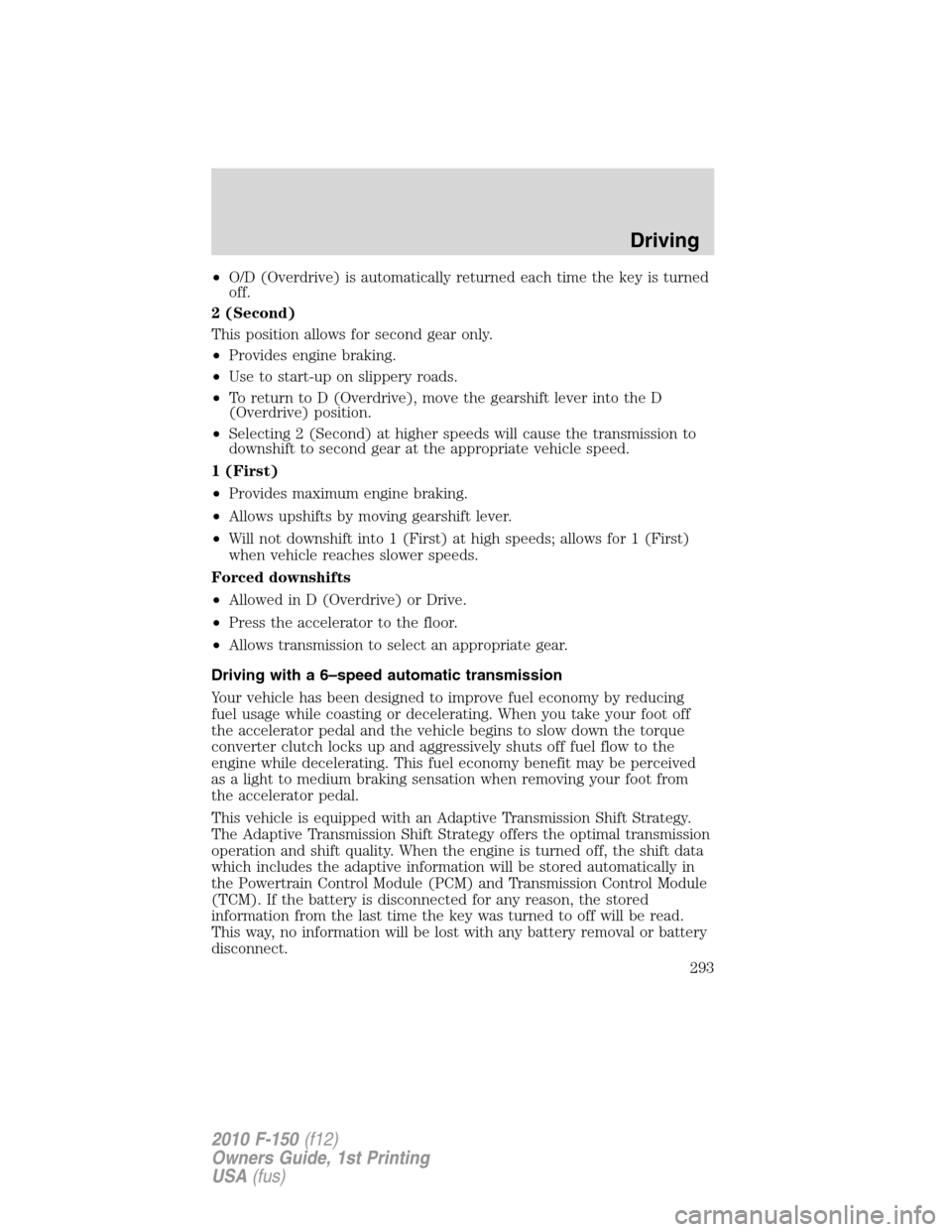
•O/D (Overdrive) is automatically returned each time the key is turned
off.
2 (Second)
This position allows for second gear only.
•Provides engine braking.
•Use to start-up on slippery roads.
•To return to D (Overdrive), move the gearshift lever into the D
(Overdrive) position.
•Selecting 2 (Second) at higher speeds will cause the transmission to
downshift to second gear at the appropriate vehicle speed.
1 (First)
•Provides maximum engine braking.
•Allows upshifts by moving gearshift lever.
•Will not downshift into 1 (First) at high speeds; allows for 1 (First)
when vehicle reaches slower speeds.
Forced downshifts
•Allowed in D (Overdrive) or Drive.
•Press the accelerator to the floor.
•Allows transmission to select an appropriate gear.
Driving with a 6–speed automatic transmission
Your vehicle has been designed to improve fuel economy by reducing
fuel usage while coasting or decelerating. When you take your foot off
the accelerator pedal and the vehicle begins to slow down the torque
converter clutch locks up and aggressively shuts off fuel flow to the
engine while decelerating. This fuel economy benefit may be perceived
as a light to medium braking sensation when removing your foot from
the accelerator pedal.
This vehicle is equipped with an Adaptive Transmission Shift Strategy.
The Adaptive Transmission Shift Strategy offers the optimal transmission
operation and shift quality. When the engine is turned off, the shift data
which includes the adaptive information will be stored automatically in
the Powertrain Control Module (PCM) and Transmission Control Module
(TCM). If the battery is disconnected for any reason, the stored
information from the last time the key was turned to off will be read.
This way, no information will be lost with any battery removal or battery
disconnect.
Driving
293
2010 F-150(f12)
Owners Guide, 1st Printing
USA(fus)
Page 319 of 419
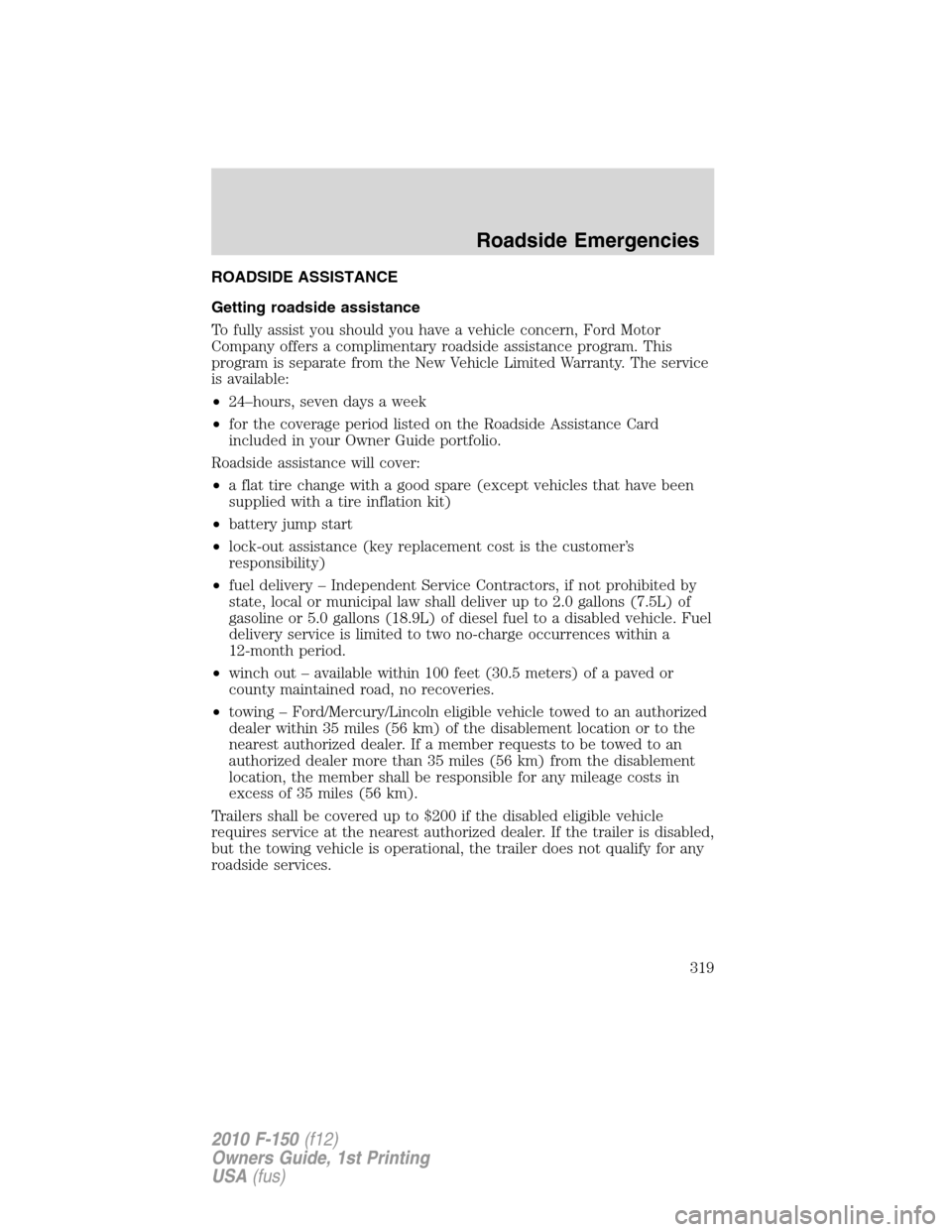
ROADSIDE ASSISTANCE
Getting roadside assistance
To fully assist you should you have a vehicle concern, Ford Motor
Company offers a complimentary roadside assistance program. This
program is separate from the New Vehicle Limited Warranty. The service
is available:
•24–hours, seven days a week
•for the coverage period listed on the Roadside Assistance Card
included in your Owner Guide portfolio.
Roadside assistance will cover:
•a flat tire change with a good spare (except vehicles that have been
supplied with a tire inflation kit)
•battery jump start
•lock-out assistance (key replacement cost is the customer’s
responsibility)
•fuel delivery – Independent Service Contractors, if not prohibited by
state, local or municipal law shall deliver up to 2.0 gallons (7.5L) of
gasoline or 5.0 gallons (18.9L) of diesel fuel to a disabled vehicle. Fuel
delivery service is limited to two no-charge occurrences within a
12-month period.
•winch out – available within 100 feet (30.5 meters) of a paved or
county maintained road, no recoveries.
•towing – Ford/Mercury/Lincoln eligible vehicle towed to an authorized
dealer within 35 miles (56 km) of the disablement location or to the
nearest authorized dealer. If a member requests to be towed to an
authorized dealer more than 35 miles (56 km) from the disablement
location, the member shall be responsible for any mileage costs in
excess of 35 miles (56 km).
Trailers shall be covered up to $200 if the disabled eligible vehicle
requires service at the nearest authorized dealer. If the trailer is disabled,
but the towing vehicle is operational, the trailer does not qualify for any
roadside services.
Roadside Emergencies
319
2010 F-150(f12)
Owners Guide, 1st Printing
USA(fus)
Page 321 of 419

Note:With extended use, the flasher may run down your battery.
FUEL PUMP SHUT-OFF
In the event of a moderate to severe collision, this vehicle is equipped
with a fuel pump shut-off feature that stops the flow of fuel to the
engine. Not every impact will cause a shut-off.
Should your vehicle shut off after a collision due to this feature, you may
restart your vehicle by doing the following:
1. Turn the ignition switch to the off position.
2. Turn the ignition switch to the on position.
In some instances the vehicle may not restart the first time you try to
restart and may take one additional attempt.
WARNING:Failure to inspect and if necessary repair fuel leaks
after a collision may increase the risk of fire and serious injury.
Ford Motor Company recommends that the fuel system be inspected
by an authorized dealer after any collision.
FUSES AND RELAYS
Fuses
If electrical components in the
vehicle are not working, a fuse may
have blown. Blown fuses are
identified by a broken wire within
the fuse. Check the appropriate
fuses before replacing any electrical
components.
Note:Always replace a fuse with one that has the specified amperage
rating. Using a fuse with a higher amperage rating can cause severe wire
damage and could start a fire.
15
Roadside Emergencies
321
2010 F-150(f12)
Owners Guide, 1st Printing
USA(fus)
Page 325 of 419

Fuse/Relay
LocationFuse Amp
RatingProtected Circuits
33 10A Trailer brake controller
34 5A Electronic locking differential
indicator
35 10A Rear park assist
36 5A Passive anti-theft system
transceiver
37 10A Upfitter relay coils
38 20A Subwoofer
39 20A Radio, Navigation display
40 20A Rear heated seats module
41 15A Auto dimming rear view mirror,
Door lock switch illumination,
Radio accessory delay
42 10A Not used (spare)
43 10A Heated mirror/backlight relay,
Rain sensor, Reverse camera
44 10A Not used (spare)
45 5A Front wiper logic, Blower motor
relay
46 7.5A Occupant classification sensor
(OCS)
47 30A Circuit
BreakerPower windows, Moon roof,
Power sliding backlight
48 15A Delayed accessory relay (Feeds
fuse 41 and circuit breaker 47)
Power distribution box
The power distribution box is located in the engine compartment. The
power distribution box contains high-current fuses that protect your
vehicle’s main electrical systems from overloads.
WARNING:Always disconnect the battery before servicing high
current fuses.
Roadside Emergencies
325
2010 F-150(f12)
Owners Guide, 1st Printing
USA(fus)
Page 326 of 419

WARNING:To reduce risk of electrical shock, always replace
the cover to the Power Distribution Box before reconnecting the
battery or refilling fluid reservoirs.
If the battery has been disconnected and reconnected, refer to the
Batterysection of theMaintenance and Specificationschapter.
The high-current fuses are coded as follows:
Fuse/Relay
LocationFuse Amp
RatingProtected Circuits
1 — Powertrain control module (PCM)
power relay
2 — Starter relay
3 — Blower motor relay
4 — Heated backlite relay
5 — Electric fan relay (high speed)
6 — Trailer tow park lamp relay
7 — Upfitter 1 relay
8 — Fuel pump
9 — Trailer tow battery charger
10 — Upfitter 2 relay
Roadside Emergencies
326
2010 F-150(f12)
Owners Guide, 1st Printing
USA(fus)
Page 327 of 419
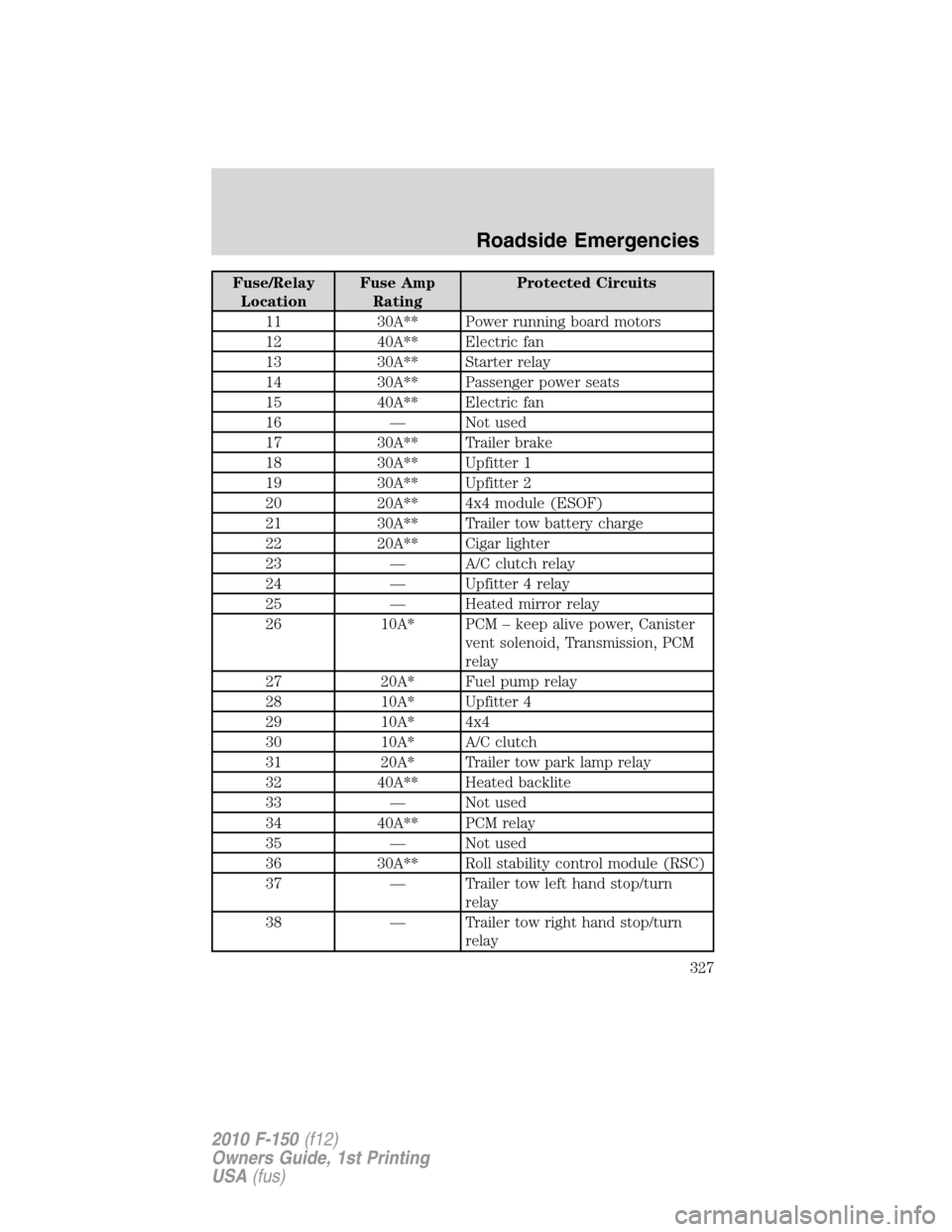
Fuse/Relay
LocationFuse Amp
RatingProtected Circuits
11 30A** Power running board motors
12 40A** Electric fan
13 30A** Starter relay
14 30A** Passenger power seats
15 40A** Electric fan
16 — Not used
17 30A** Trailer brake
18 30A** Upfitter 1
19 30A** Upfitter 2
20 20A** 4x4 module (ESOF)
21 30A** Trailer tow battery charge
22 20A** Cigar lighter
23 — A/C clutch relay
24 — Upfitter 4 relay
25 — Heated mirror relay
26 10A* PCM – keep alive power, Canister
vent solenoid, Transmission, PCM
relay
27 20A* Fuel pump relay
28 10A* Upfitter 4
29 10A* 4x4
30 10A* A/C clutch
31 20A* Trailer tow park lamp relay
32 40A** Heated backlite
33 — Not used
34 40A** PCM relay
35 — Not used
36 30A** Roll stability control module (RSC)
37 — Trailer tow left hand stop/turn
relay
38 — Trailer tow right hand stop/turn
relay
Roadside Emergencies
327
2010 F-150(f12)
Owners Guide, 1st Printing
USA(fus)
Page 328 of 419
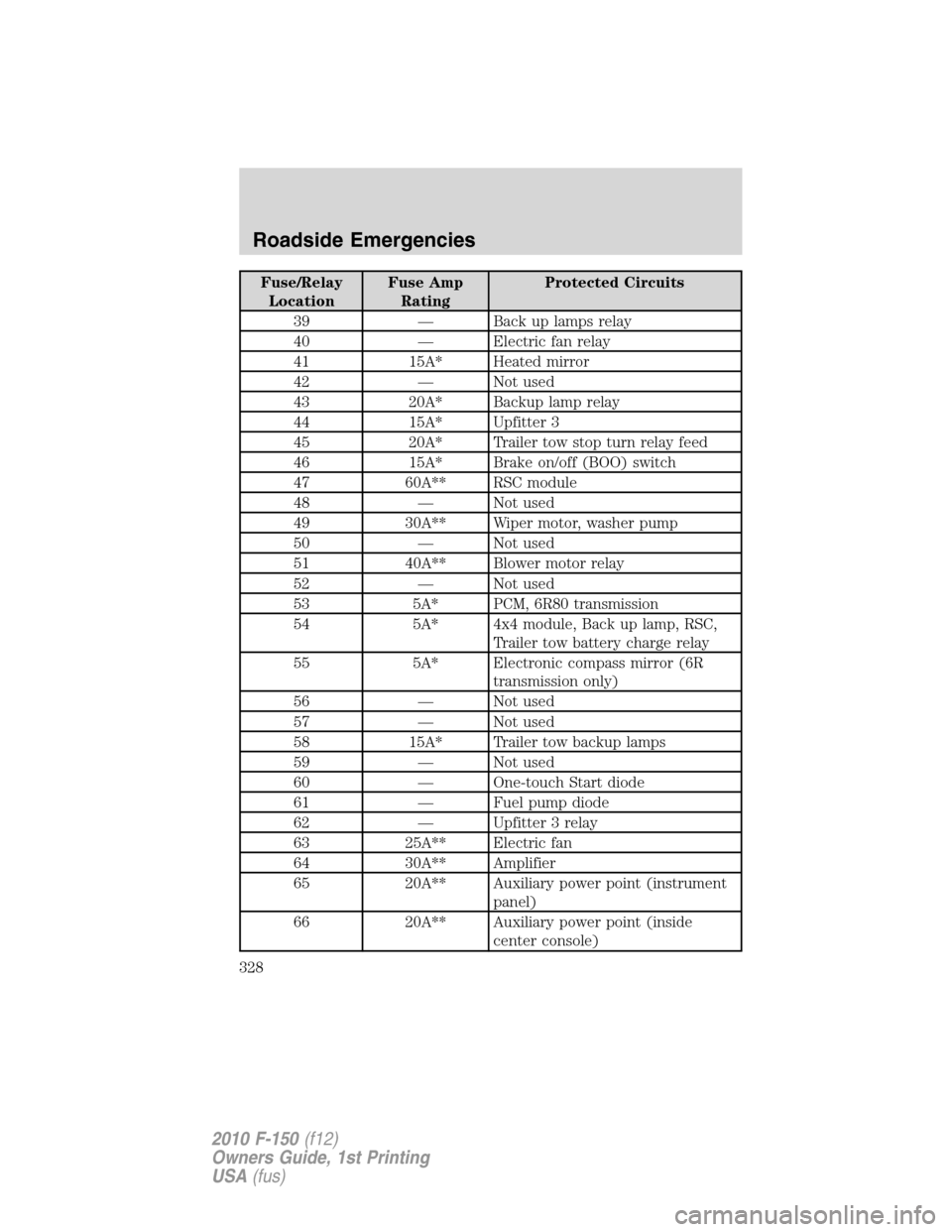
Fuse/Relay
LocationFuse Amp
RatingProtected Circuits
39 — Back up lamps relay
40 — Electric fan relay
41 15A* Heated mirror
42 — Not used
43 20A* Backup lamp relay
44 15A* Upfitter 3
45 20A* Trailer tow stop turn relay feed
46 15A* Brake on/off (BOO) switch
47 60A** RSC module
48 — Not used
49 30A** Wiper motor, washer pump
50 — Not used
51 40A** Blower motor relay
52 — Not used
53 5A* PCM, 6R80 transmission
54 5A* 4x4 module, Back up lamp, RSC,
Trailer tow battery charge relay
55 5A* Electronic compass mirror (6R
transmission only)
56 — Not used
57 — Not used
58 15A* Trailer tow backup lamps
59 — Not used
60 — One-touch Start diode
61 — Fuel pump diode
62 — Upfitter 3 relay
63 25A** Electric fan
64 30A** Amplifier
65 20A** Auxiliary power point (instrument
panel)
66 20A** Auxiliary power point (inside
center console)
Roadside Emergencies
328
2010 F-150(f12)
Owners Guide, 1st Printing
USA(fus)